Historical monuments: Neither as still nor as silent as stones
By: Camilo Calderón Acero
Photos:
Society and Culture
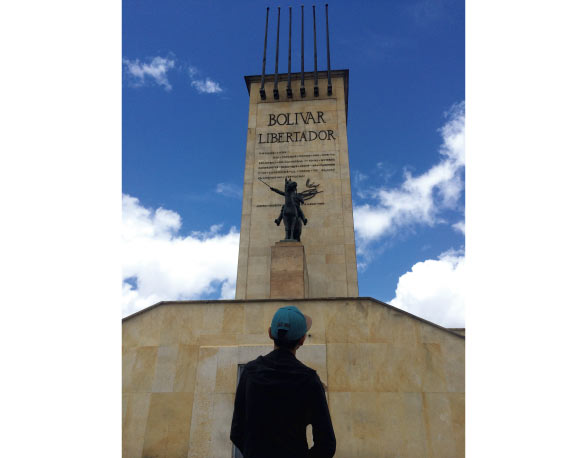
By: Camilo Calderón Acero
Photos:
“Bolívar passed through here” is a phrase repeated in stone in many of the municipalities of our geography. It is reiterated so much that it has even lost significant value. However, this simple reminder points out the importance of monuments for peoples and their memory. They are not only relevant for what they honor, but also for the sense that people give them over time.
Cases like the previous one allow to speak of a ‘historicity’ of the monuments, in contrast to that static and immobile conception with which it could be linked to the statues, obelisks, plates, pedestals, sculptures and other commemorative sites. This is the perspective that guided the research work led by the historian Sebastián Vargas Álvarez, associate professor of History in the School of Human Sciences at Universidad del Rosario.
“The coined concept is that of historicity, specifically the one that links it with the study of monuments,” Vargas explains. “Thus, the central idea that motivates the research project is to think of monuments as specific historical objects, but at the same time they are contingent. They change over time, so they can be rescued, interpreted and reused in different ways and at different times. That is what the concept of historicity seeks to highlight,” he adds.
From this approach, since 2018 a broad research project was developed that included not only Professor Vargas, but also a research group, a seedbed and several experts from different universities and academic levels (between teachers and graduates). That hard work culminated in 2023 with two written works that compiled this complex investigative work.
These are the books La materialización del pasado: monumentalización, memoria y espacio público en Colombia (The Materialization of the Past: Monumentalization, Memory, and Public Space in Colombia) and Mutaciones de la piedra: pensar el monumento desde Colombia (Mutations of Stone: Thinking the Monument from Colombia), published by Universidad del Rosario. The first of these titles corresponds to a work in which different cases of study are recorded and detailed; many of them product of the work carried out in spaces such as the research group Social studies of memory and heritage and Public history. This is a space coordinated by Professor Vargas together with teachers Ana Guglielmucci and Héctor García, from the Anthropology program.
In this collective work, the interdisciplinary and critical approach to history, led and proposed by Vargas, materializes: “My experience has been focused on different objects, discourses and practices about the past, but that do not necessarily start from professional historiography or academia. That is why I was very interested to see how people, in different contexts and types of social agreements, interpret history and what they use it for.”
In 2018, this exploration of monuments begins, in which a critical analysis that values their magnitude prevails, while they are not only considered as objects placed in public space, but, in agreement, rescues their symbolic component. “Much of what exists is limited to inventories that only describe these works and that do not go beyond. That is why it is important to point out that monumentalization in our country has been exclusive and has generated that the representation of the national past in the public space is full of groups that claim gender, ethnic or social issues, among many others, find in these actions a mechanism to be visible.
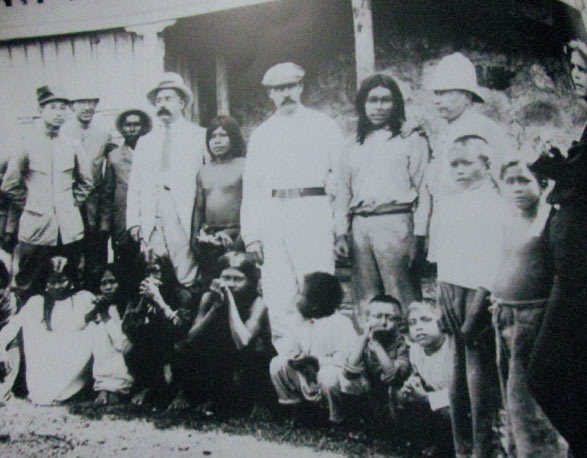
Consular Commission to the Putumayo River and its Affluents, Peruvian Consul, Mr. Rey de Castro, Commissioner Mr. Lores, Commander Castro et al. [Photograph/16.5 x 11.8 cm], 1912, La Chorrera. Source: Photo Album. Taken in Journey of the Consular Commission to the Putumayo River and its Affluents (August to October 1912), Lima: Task, 2013, p. 66.
This focus is the one that guides the book The materialization of the past , where several cases are collected in 13 chapters through the gaze and the deep analysis of 18 different authors. Notable examples include monuments located in Bogotá, Cali, Ibagué, Cartagena, Leticia and Funza, among others. This gives an account of the various possibilities that exist to approach this object of study, not only from its material value, but also from its symbolic resignifications. It is a work with a broad methodological design that, in the words of its editor, aims to make a significant contribution to the cultural history of Colombian monuments, in an integral way.
To cite an example of the above, it is worth mentioning the case study on the monument to Los Héroes in Bogotá and its role in the recent ‘social outburst’, which Vargas conducted along with the fellow historian Marcela Randazzo Ruiz, specialist in Museology and Management of Cultural Heritage of Universidad de Barcelona and PhD in Society and Culture of the same educational institution.
For the co-author this work is valuable because it allows to approach the monument in connection with the urban space. “This one seems indispensable to me because often the monument is analyzed in isolation, without its different links. The city in the end is alive, it is constantly changing, and I think that is in line with the resignifications, the appropriation of space and the construction of memory,” he says.
‘Los Héroes’ and the history of ‘changing monuments’
Although it is easy for many passers-by to relate the name of the Los Héroes sector in Bogotá to the monument that until 2022 was located at the junction of the North Highway with 80th Street, it is not known to everyone that its main element, the equestrian statue, was not always there. The building was completed only in 1963, while the statue was erected in 1910, as part of the centenary commemoration of the ‘Cry of Independence’.
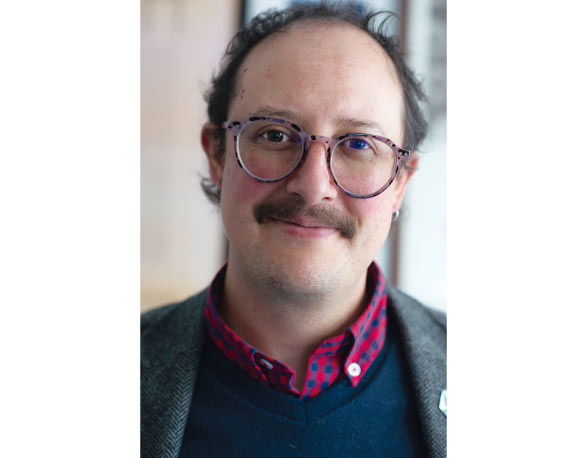
“The central idea that motivates the research project is to think of monuments as specific historical objects, but at the same time they are contingent. They change over time, so they can be rescued, interpreted and reused in different ways and at different times...,” explains Professor Sebastián Vargas from the School of Human Sciences at Universidad del Rosario.
In its journey this sculpture, 3.3 meters high and sculpted by the French artist Emanuel Fremiet, was originally located in Independence Park, very close to where today is the District Planetarium. It was then kept in a warehouse due to the expansion of El Dorado Avenue (or 26th Street) until 1962 when it was joined to the Monument to Los Héroes, where it remained until it was removed to give rise to the future first metro line of Bogotá. As a “swan song”, before its disappearance the monument witnessed the citizen congregations from 2019 to 2021, which rekindled attention to this representative place of the city.
In addition to the short-term events of the National Strike at that time, the work that Professor Vargas had been developing with Marcela Randazzo on this monument was added. “We combined what was found in the archives with an ethnographic observation on the ground. We review some characteristics of the materiality of the monument, such as its size and shapes; likewise, the historical representations that project not only this monument, but also its entire surrounding space. For example, we analyze what practices and social relations exist or not around them or what social actors interact with them,” Vargas explains.
For this reason, the first thing was to look to primary sources, such as the Bogotá Archive, the District Institute of Cultural Heritage (IDPC) and the National Library, to look for maps and plans of that time, as well as all the legislation related to the life of the monument. This also includes consulting the press and photographic archive.
“With the review of primary sources, you can know about the entire historical process, from the gestation of the monument to the meanings given to it by citizenship,” says Randazzo. “However, it does not stay there, we also study how they are resignifying in time and are forming a “palimpsest” of memory. In the 70s of the last century a shopping center with the same name was built next to it and later the Transmilenio station was built. It is given at the same time a spatial overwrite and a disappearance. This is what allows us to speak of ‘monumentalization’.”
Peripheral monumentalization processes
Both in Los Héroes and in other monuments you can talk about a changing flow that varies with time. This is the case of the chapter on the processes of monumentalization in the center of Leticia (Amazonas), by Paulo Córdoba, historian and master's degree in Philosophy from Universidad del Rosario and currently on his doctoral degree in Amazonian Studies from the Universidad Nacional de Colombia, Amazon campus.
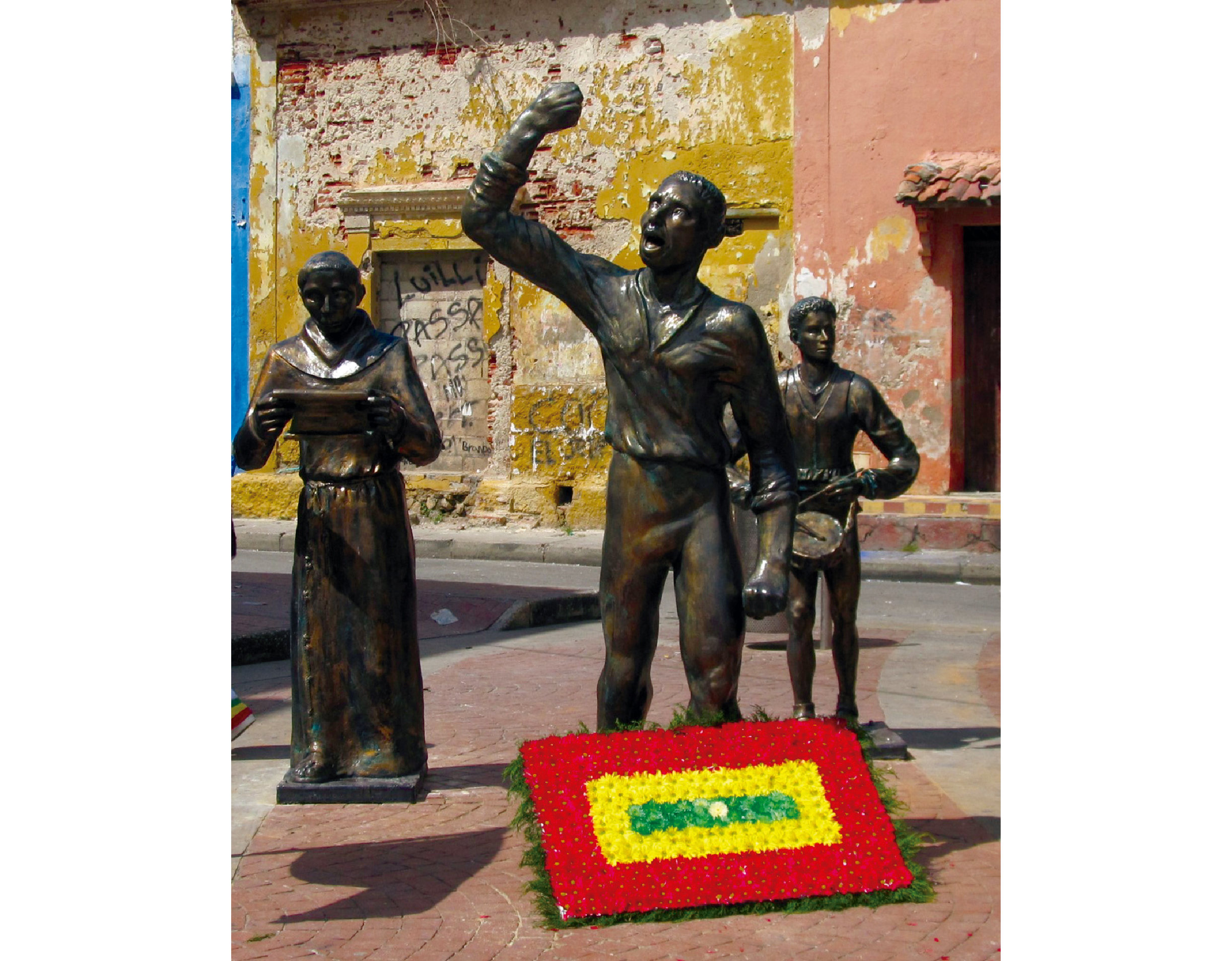
The Statue of Pedro Romero in Getsemaní. Laura De la Rosa Solano (2011). This monument is one of the few sites in Colombia that deal with the country's Afrodescendant history, beyond the issue of slavery. Clearly, it constitutes a sample of those diverse memories that can emanate from the monuments.
At the beginning of his research, Professor Córdoba found that there was no adequate organization, protection, classification and access to documentation about the monuments in the city, so it was essential to go beyond the archives of the local library or what the authorities of the place told him. He had to go to primary sources, from the community, to give his testimony from the close knowledge of the territory, which even allowed to summon inhabitants in search of the photographic shots of the monuments.
“Beyond just drawing attention to the existence of a process of monumentalization, which took place in the middle of the Amazon rainforest, what I was looking for was to circulate some stories that I had read and heard in my daily life in Leticia,” explains Córdoba. “With that, I wanted to pay tribute to sources and voices that daily transmit knowledge in written or oral form to younger generations.”
In front of the traditional monuments, Francisco de Paula Santander (Santander Park), Francisco de Orellana (Orellana Park) and the anonymous soldier of the Colombian-Peruvi-an war, new places and memory practices associated with indigenous cultures are contrasted. Examples of this are the resignifications that these communities give to the still materialized presence of the Casa Arana building, in the area of La Chorrera, place of multiple tortures to the indigenous population of the Amazon during the time of the exploitation of rubber in the first third of the 20th century.
Thus new readings arise not only about what these spaces are and represent, but also about the prevalence and omission of discourses around them. “The different case studies offered by the book allow us to see how the narrated history has excluded different historical subjects, different moments, different experiences and trajectories,” Vargas explains. “We see that in these stories there is a very strong imbalance in elements of race and social stratum, among others.”
Interest in the processes of monumentalization in the Amazon has recently attracted the interest of other scholars. In 2021, an article about monuments to the settlers was published, written by the professor and anthropologist of Universidad Nacional, Gabriel Cabrera, who focused on case studies of Vaupés, Guaviare and Caquetá.
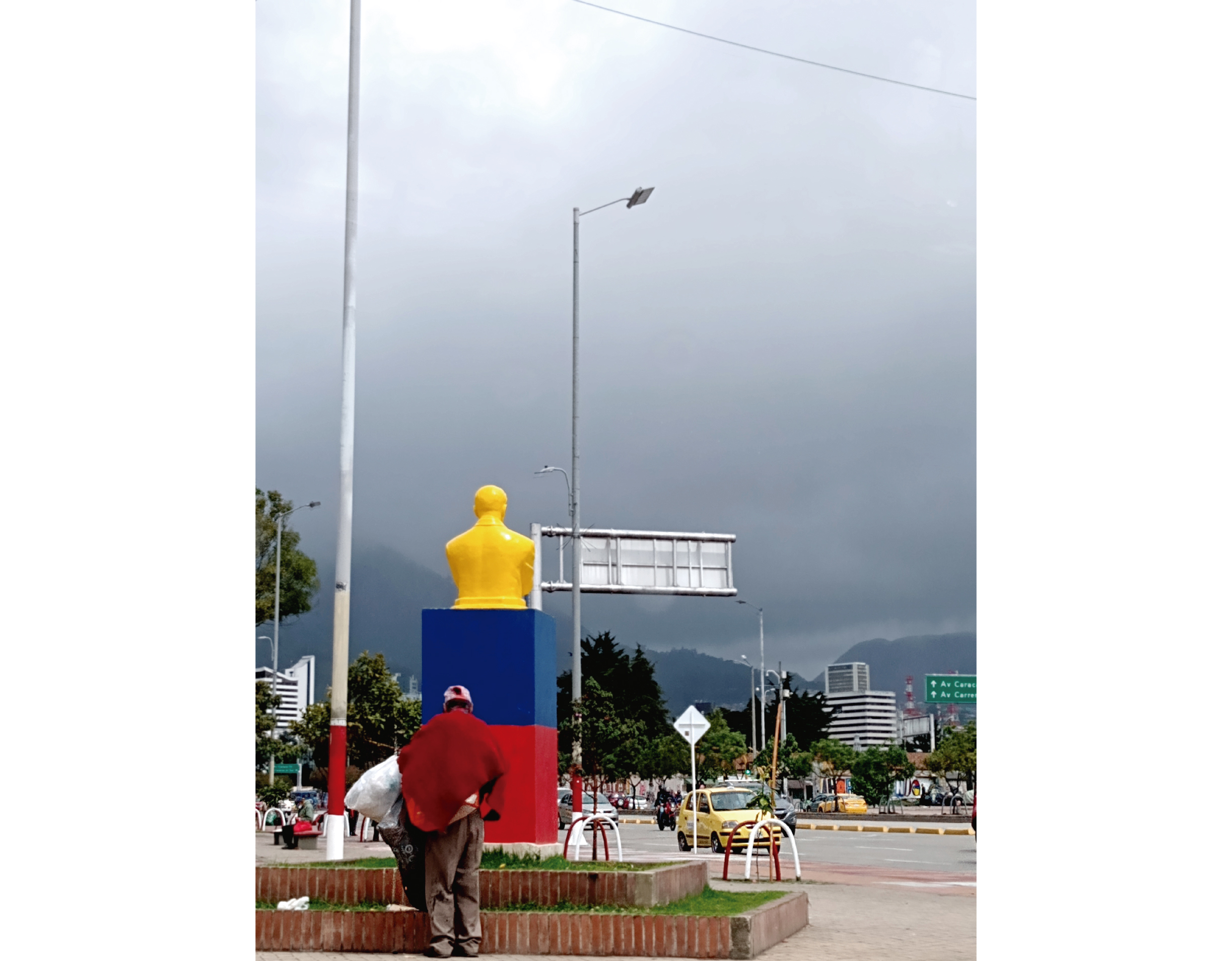
Photo by Oswaldo Vargas, 2021.
A cornerstone for talking about monuments
The sample collected in the compilation book La Materialización del pasado “The Materialization of the past” would not have been possible without a powerful theoretical and methodological support, which was worked by Professor Vargas since 2018 after completing his doctoral studies in History at Universidad Iberoamericana in Mexico City.
Likewise, all the archival and bibliographic research, including the legal framework, carried out by Vargas allowed him to construct the theoretical definitions about the monuments, which would be the basis of his field work that at the same time allowed him to address the subject within all its complexity. This framework was materialized in the book Mutaciones de piedra “Stone mutations,” which could become a reference on the subject of monuments.
“I did a thorough review to build a historiographical balance on the case studies and everything that has been studied and written in the area since the late 18th century, the whole 19th century and up to the present. It is a profound work that offers a series of theoretical definitions of the monument, which allow us to understand it from its different variables: its materiality, its spatiality; from memory or from the political, to mention a few", the author explains.
This makes the text a useful reference work for students and researchers, as well as an instrument for considering public policies related to cultural heritage. Based on their approaches, the possibility of approaching monuments with a greater number of variables and better analysis tools is opened. In particular, at a time when they have been the target of attacks, demolitions and resignifications by various social groups.
In addition, the work initiated by Professor Vargas and the other researchers not only reveals the written works, but in the future processes of socialization with the communities in Bogotá and in the regions that were nuclei of field work to develop the content of the books are advanced, something that is considered essential for this critical approach proposed in them. For example, discussions will be scheduled with the communities of Leticia and Cartagena.
For his part, this historian continues to look for new crosses like the one that links art and public space. Among his next works is one related to posters and interventions in the public space that circulated at the time of the social outbreak, which aims to make visible the contemporary resignifications and appropriations that currently live the monuments.